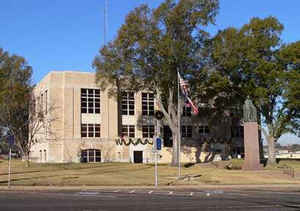Texas Counties
Texas is divided into two hundred and fifty-four counties, more than any other state. Texas was originally divided into municipalities, a unit of local government under Spanish and Mexican rule. When the Republic of Texas gained its independence in 1836, there were 23 municipalities, which became the original Texas counties. Many of these would later be divided into new counties. The most recent county to be created was Kenedy County in 1921. The most recent county to be organized was Loving County in 1931Rusk County, Texas
Rusk County Education, Geography, and History

Rusk County is a county located in the state of Texas. Based on the 2010 census, its population was 53,330. Its county seat is
Henderson. The county is named for Thomas Jefferson Rusk, a secretary of war of the Republic of Texas.
Rusk County is part of the Longview, TX Metropolitan Statistical Area as well as the Longview-Marshall, TX Combined Statistical Area.
Etymology - Origin of Rusk County Name
Thomas Jefferson Rusk, a general in the Texas Revolution and leading statesman in the new state
Demographics:
County QuickFacts: CensusBureau Quick Facts
Rusk County History
Originally a part of Nacogdoches County, Rusk was established as its own county by the Congress of the Republic of Texas on January 16, 1843. By 1850, it was the second most populous county in Texas out of the 78 counties that had been organized at that time. Its seat is Henderson. Rusk County is named for Thomas Jefferson Rusk, a secretary of war of the Republic of Texas.
Handbook of Texas
The area has been the site of human habitation for several thousand
years. Archeological artifacts suggest that the earliest human inhabitants
arrived during the Archaic Period, 2,000 to 3,000 years ago. Evidence
of the prehistoric Caddo culture, which flourished between A.D. 1000
and 1600, has also been found in the area, and the earliest Spanish
explorers encountered the remnants of that culture during their first
forays into the region. Between 1761 and 1810 two Tejas villages are
known to have existed in the area of the future county: Aynais, in the
southwestern corner of the present county, and Nacogdoches Village,
near the site of present Minden. As many as four early Spanish expeditions
crossed what is now Rusk County between 1691 and 1788. Domingo Ter?
de los R?s crossed the area on his way to the northeast
in 1691, and Domingo Ram? led an expedition across the
county around 1717. Fray Jos?Calahorra y Saenz passed
through the southwestern corner in September 1760, and in 1788 Pedro
Vial traversed the northern portion of the future county.
Although the area was part of the Department of Nacogdoches, the Spanish
never built any permanent settlements in it, and today very little Spanish
or Mexican influence can be seen in the county except for the names
of a few streams. The first Anglo-American settlers came into Rusk County
as early as 1829. The earliest land grant within the present-day borders
of the county was issued to William Elliott on March 22, 1829; other
early grantees included the brothers Thomas and Leonard Williams, Joseph
Durst, and Henry Stockman. By 1834 white settlers began
to arrive in large numbers; between May 2 and November 23, 1834, the
Mexican government issued forty-three land grants in the area, the majority
of them to recent American immigrants. After the Texas Revolution,
the population grew rapidly, as new settlers arrived by way of Trammel's
Trace, the Nacogdoches Road, and the Green Grass Trail.
Cherokee and Shawnee Indians under the leadership of Chief Bowl
occupied the western part of the area during the 1820s and 1830s, but
with their removal after the Cherokee War in 1839 the way
was opened for white settlement. Most of the new colonists came from
the Old South, particularly Tennessee, Georgia, North Carolina, and
South Carolina, attracted by the availability of abundant cheap land.
Although most of the early settlers were of modest means, some were
wealthy planters, among them James Smith, Julien Sidney Devereux,
and Albert Tatum, who brought sizable numbers of slaves with them. After
Texas independence the territory was originally a part of Nacogdoches
County, but upon an act of the Congress of the Republic of Texas,
Rusk County was formed on January 16, 1843, and was named for Thomas
Jefferson Rusk, who had been secretary of war under President
Sam Houston. The county seat was established as near the
center of the county as possible by the five commissioners appointed
to acquire land for the purpose. Gen. James Smith donated the original
townsite of 65.5 acres, and he later sold 69.5 acres more to the town.
Later, William B. Ochiltree donated five acres north of
the town square and in the deed named the town for his friend James
Pinckney Henderson. More at
Virginia Knapp and Megan Biesele, "RUSK COUNTY," Handbook of Texas Online (http://www.tshaonline.org/handbook/online/articles/hcr12),
accessed January 24, 2016. Uploaded on June 15, 2010. Published by the Texas State Historical Association.
Geography: Land and Water
As reported by the Census Bureau, the county has a total area
of 939 square miles (2,431 km2), of which, 924 square miles (2,392 km2)
of it is land and 15 square miles (39 km2) of it (1.61%) is water
Neighboring Counties
Bordering counties are as follows:
- Gregg County (north)
- Harrison County (northeast)
- Panola County (east)
- Shelby County (southeast)
- Nacogdoches County (south)
- Cherokee County (southwest)
- Smith County (northwest)
Education
The following school districts serve Rusk County:
Carlisle ISD
Cushing ISD (mostly in Nacogdoches County)
Garrison ISD (mostly in Nacogdoches County)
Henderson ISD
Kilgore ISD (mostly in Gregg County)
Laneville ISD
Leverett's Chapel ISD
Mount Enterprise ISD
Overton ISD
Rusk ISD (mostly in Cherokee County)
Tatum ISD (partly in Panola County)
West Rusk ISD
Rusk County's first officially authorized school was the Rusk County Academy.







